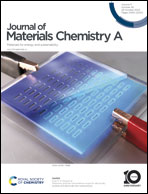Molecular dynamics-machine learning approaches for the accurate prediction of electrochemical windows of ionic liquid electrolytes for dual-ion batteries†
Abstract
Electrochemical window (ECW) potential is a key parameter for estimating voltage and understanding electrolyte stability. Determining the ECW is challenging both experimentally and computationally. Experimental ECW values vary with measurement conditions and the purity of ionic liquids (ILs), while the classical MD followed by DFT approach has been quite fruitful to achieve experimental values but limited by the lack of appropriate force fields. Herein, high throughput machine learning (ML) techniques are considered to predict the ECW of different organic cation based ILs. To train ML models, ECW values are calculated using the MD-DFT method. Among the seven considered algorithms, extra trees regression (ETR) emerges as the optimal model, exhibiting a low MAE of 0.37 V for the ECW prediction. Our ML predicted MAE of 0.37 V surpasses the previous DFT computed MAE of 0.68 V for two different methods of ECW calculation. The ML model successfully predicts the ECW of 660 IL electrolytes, and the interpretable SHAP library provides insight regarding local and global feature contributions. The predicted ECW values align well with experimental values, offering a promising alternative to expensive computational and tedious experimental approaches for electrolyte selection.



 Please wait while we load your content...
Please wait while we load your content...